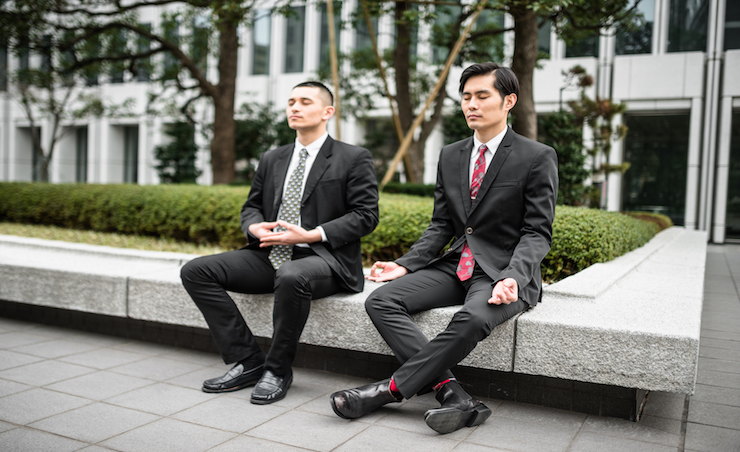 Meditation is officially mainstream. Something that seemed exclusive to yogis, monks and ninja turtles is now be enjoyed* by everyone from misbehaving children in lieu of detention to top performers on the C level of Fortune 500 companies.
Meditation is officially mainstream. Something that seemed exclusive to yogis, monks and ninja turtles is now be enjoyed* by everyone from misbehaving children in lieu of detention to top performers on the C level of Fortune 500 companies.
I threw that asterisk in there because I can’t claim to enjoy meditation (at least not yet) and I’m going to assume I’m far from alone. Sure, I enjoy the benefits of meditation, but I usually find it a tortuous process. Maybe it’s the ADHD, maybe it’s just the result of the constant stimulation and distraction I’m accustomed to as someone on the fringe of the Millennial group, but I’ve never had skill for being still.
Through my self-education, experimentation, and observation of myself and others, I’ve found ways to feel some of the benefits of meditation that more easily squeeze into my go-go-go life.
A Dose of Om
Foregoing the spiritual aspects of meditation (for this article), there are still plenty of pragmatic and documented benefits to compel you to introduce a regular practice of meditation into your day to day life. Lowering blood pressure, reducing stress, enhancing focus, improving mood… we pay billions each year for pharmaceuticals that claim some of the same benefits without even considering the solution could within us all along. However, meditation isn’t as easy as popping a pill, so finding the best way to introduce consistent practice in your day to day is paramount to your success.
Refreshed Perspective
I look at meditation as a way to remove yourself from the inside of the “bubble” that is your situation, lending more perspective and creating distance between you and the issue. If you’re like me, the first and last thing you touch each day is your phone, essentially keeping your mind going from when your head leaves the pillow until it returns (and then some).
Imagine the difference between being a player on the field and a coach observing from the sidelines. The player can only see what’s in front of him, whereas the coach can see the entire battle ground. By taking time to remove yourself from the play, turn off your inner monolog, and just observe objectively, you’re able to find a clarity you’d otherwise muddy up in the chaos.
The problem a lot of people experience with traditional meditation efforts is silencing the inner monolog, which can be helped with a couple of tricks.
Monkey Around
I listened to a monk describe the mind as a monkey, constantly messing about and getting into this or that, causing trouble carelessly. He said as long as you give the monkey a simple task, it’s easier to keep it distracted and subdued instead of running around from thought to thought.
I’ve found repeating a simple mantra in my head (“Aham”, for example, meaning “I am” in Sanskrit) is a very effective way to calm the monkey and prevent inner monolog. I’ve also found guided meditation to work better for me than ambient music, as actively listening helps keep my brain distracted enough to not produce an endless stream of thoughts.
My favorite apps are Simple Habit and HeadSpace because of their content, functionality, and features, but there are plenty to choose from. You’d be surprised how much you’ll notice by just taking 10 minutes a day to unplug and let your brain reboot.
I prefer meditating in the morning so I have that positive momentum and calmness before I walk into the office, but I’ve even taken meditation breaks in my car in the middle of the day without anyone noticing. Meditating at the end of the night is a great way to get you back to neutral before bed and “untying” yourself from events/conflicts/burdens of your day. What I remind myself about meditation is that it’s like breathing, no matter how long it’s been, it’s always a good idea to do it now.
Wax On. Wax Off.
Still having trouble with the feeling of being idle? If sitting with your eyes closed and legs crossed just seems too agonizing for you, you could practice active/working meditation. In studying philosophy, I learned Buddhist monks actually use their chores as an opportunity to meditate through mindfulness and presence.
It may not be as easy to meditate while typing an email or working on spreadsheets, but finding those “auto-pilot” tasks we perform (driving, folding clothes, washing dishes, etc) and using that time to focus on creating mental space can provide you with plenty of opportunities to gain presence.
If you can breathe, you can meditate and gain some presence. One of my business mentors (a former Buddhist monk) washes and waxes his Jag every weekend. I used to think he had too much time on his hands, but now I see that as his time to unplug and reset for the upcoming week.
That realization reminded me of when I got into sewing with a crafty ex-girlfriend. There was something so calming and therapeutic about focusing on a mindless task at the end of the day. As an entrepreneur, often operating in an abstract world where results from efforts are rarely seen immediately or directly measurable, it was also very rewarding to see a visible and tangible mark of progress from the X hours of effort sewing.
Hurry Up and Stop
The non-stop, fast-paced modern lives we live can make it all too easy to exist in a state of constant fixation on an ever-changing myriad of thoughts, creating an ideal breeding ground for anxiety and stress. Even taking a few minutes a day to recenter yourself may be the most rewarding investment in yourself that you can make.
Whether it’s tinkering with your car, working out, or knitting sweaters for your hairless cat, find opportunities to distract your monkey-mind which you can practice frequently. As entrepreneurs, we may be too busy to notice the toll our hectic lives take on us so it’s important to find time to defrag our brains and clear our mental cache.
Success is based on consistency, consistency is based on convenience, and convenience is based on finding what works for you. Turning mindlessness into mindfulness is it’s own beautiful alchemy that takes no additional time or energy, just effort.



